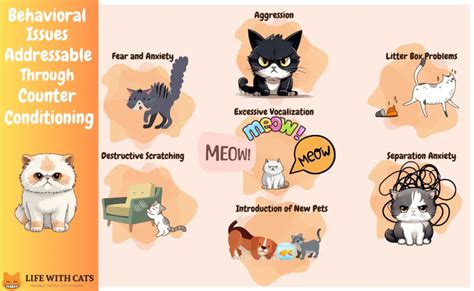Introduction
Cats, with their captivating charm and playful antics, have become beloved companions in countless households. However, for some felines, everyday experiences can spark intense fear and anxiety, posing challenges for both themselves and their owners. Here’s where the powerful techniques of desensitization and counterconditioning come into play.

Understanding Cat Desensitization and Counterconditioning
Desensitization:
A gradual process that involves exposing the cat to the feared stimulus at a low intensity while ensuring that they remain below their anxiety threshold. This allows them to gradually adapt and become less reactive to the trigger.
Counterconditioning:
Pairing the feared stimulus with something pleasant, such as treats, praise, or play. Over time, the cat learns to associate the once-dreaded experience with positive outcomes, reducing their anxiety.
Why Desensitization and Counterconditioning Matter
- Reduced Fear and Anxiety: By addressing the root of the cat’s fear, these techniques effectively alleviate their distress, improving their overall well-being.
- Improved Quality of Life: Fearful cats often avoid normal activities, leading to isolation and reduced quality of life. Desensitization and counterconditioning empower them to participate fully in their surroundings.
- Enhanced Owner-Cat Bond: By patiently guiding their feline companions through this process, owners strengthen their bond and foster a harmonious relationship.
How to Implement Cat Desensitization and Counterconditioning
1. Identify the Trigger:
Start by closely observing your cat’s behavior to pinpoint the specific stimuli that elicit fear responses. Common triggers include loud noises, unfamiliar people, certain objects, or veterinary visits.
2. Set Up a Safe Space:
Create a dedicated area where your cat feels secure and at ease. This space should be free from the identified trigger and provide access to resources such as water, food, and a litter box.
3. Gradual Exposure:
Slowly introduce the feared stimulus into the cat’s environment at the lowest possible intensity that does not provoke an anxiety response. Gradually increase the intensity over time, remaining within the cat’s comfort zone.
4. Countercondition with Rewards:
Whenever the cat is exposed to the trigger, immediately pair it with something pleasant, such as treats, praise, or interactive play. This helps the cat associate the trigger with positive experiences.
5. Repeat and Reward:
Consistently repeat the desensitization and counterconditioning process, gradually increasing the intensity of the trigger and the duration of exposure. Remember to reward your cat generously for their progress.
Case Study: Helping Max Overcome Fear of the Vacuum Cleaner
Max, a timid tabby, cowered in fear whenever the vacuum cleaner was turned on. Using desensitization and counterconditioning, his owner Emily began by placing the vacuum on the floor without turning it on and rewarding Max with treats. Over several weeks, she gradually increased the proximity and duration, pairing the vacuum’s presence with positive experiences. Eventually, Max lost his fear and even became curious about the appliance, transforming his vacuum-induced anxiety into a new opportunity for treats and attention.
Tips for Success
- Start Small: Begin with a very low intensity trigger to avoid overwhelming your cat.
- Move at the Cat’s Pace: Gradually increase the intensity of the trigger and the duration of exposure, respecting your cat’s level of comfort.
- Be Patient and Consistent: Desensitization and counterconditioning require time and repetition. Stay patient and don’t rush the process.
- Seek Professional Help: If you encounter challenges or resistance, consider consulting with a certified animal behaviorist or veterinarian for guidance.
Trending Techniques and Innovations
Virtual Reality Therapy:
Virtual reality technology is emerging as a promising tool for cat desensitization. By creating immersive environments that simulate the feared stimulus in a controlled setting, cats can gradually overcome their anxieties.
Adaptil Diffusers:
These diffusers release synthetic cat pheromones, creating a calming atmosphere that promotes relaxation and reduces fear.
Thundershirts:
These snug-fitting garments apply gentle pressure, providing a sense of security and reducing anxiety in fearful cats.
Improve Your Cat’s Future with Desensitization and Counterconditioning
Empowering your cat to overcome their fears opens up a world of possibilities for both of you. Not only will their quality of life improve, but you’ll also enjoy a deeper and more fulfilling relationship. Embrace the techniques of desensitization and counterconditioning today, and watch your cat’s transformation from fear to fun.





















